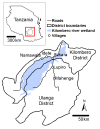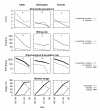Impact of promoting longer-lasting insecticide treatment of bed nets upon malaria transmission in a rural Tanzanian setting with pre-existing high coverage of untreated nets
- PMID: 20579399
- PMCID: PMC2902500
- DOI: 10.1186/1475-2875-9-187
Impact of promoting longer-lasting insecticide treatment of bed nets upon malaria transmission in a rural Tanzanian setting with pre-existing high coverage of untreated nets
Abstract
Background: The communities of Namawala and Idete villages in southern Tanzania experienced extremely high malaria transmission in the 1990s. By 2001-03, following high usage rates (75% of all age groups) of untreated bed nets, a 4.2-fold reduction in malaria transmission intensity was achieved. Since 2006, a national-scale programme has promoted the use of longer-lasting insecticide treatment kits (consisting of an insecticide plus binder) co-packaged with all bed nets manufactured in the country.
Methods: The entomological inoculation rate (EIR) was estimated through monthly surveys in 72 houses randomly selected in each of the two villages. Mosquitoes were caught using CDC light traps placed beside occupied bed nets between January and December 2008 (n = 1,648 trap nights). Sub-samples of mosquitoes were taken from each trap to determine parity status, sporozoite infection and Anopheles gambiae complex sibling species identity.
Results: Compared with a historical mean EIR of approximately 1400 infectious bites/person/year (ib/p/y) in 1990-94; the 2008 estimate of 81 ib/p/y represents an 18-fold reduction for an unprotected person without a net. The combined impact of longer-lasting insecticide treatments as well as high bed net coverage was associated with a 4.6-fold reduction in EIR, on top of the impact from the use of untreated nets alone. The scale-up of bed nets and subsequent insecticidal treatment has reduced the density of the anthropophagic, endophagic primary vector species, Anopheles gambiae sensu stricto, by 79%. In contrast, the reduction in density of the zoophagic, exophagic sibling species Anopheles arabiensis was only 38%.
Conclusion: Insecticide treatment of nets reduced the intensity of malaria transmission in addition to that achieved by the untreated nets alone. Impacts were most pronounced against the highly anthropophagic, endophagic primary vector, leading to a shift in the sibling species composition of the A. gambiae complex.
Figures



References
-
- Beier JC, Killeen GF, Githure JI. Short report: Entomologic inoculation rates and Plasmodium falciparum malaria prevalence in Africa. Am J Trop Med Hyg. 1999;61(1):109–113. - PubMed
-
- Lengeler C. Insecticide-treated bednets and curtains for preventing malaria (Review) Cochrane Database Syst Rev. 2004;2:CD000363. - PubMed
Publication types
MeSH terms
Substances
Grants and funding
LinkOut - more resources
Full Text Sources
Medical

